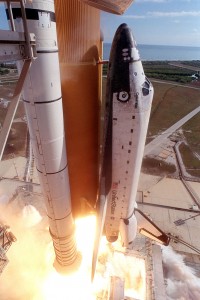It is difficult to hear the Space Shuttle program has reached the end of the run. After a 30-year span, NASA will retire the remaining vehicles – all of which will go to museums around the nation.
Discovery, the oldest and highest time shuttle will go to the Air and Space Museum at the Steven F. Udvar-Hazy Center.
Endeavor, slated to fly later this month, will find a final resting place at the California Science Center in Los Angeles. The Shuttle Atlantis will remain at the Kennedy Space Center in Florida.
The Enterprise, the first shuttle built, never flew in space. The contractors delivered Enterprise without engines or a functional heat shield. The purpose of Enterprise was functional; NASA would use her for glide testing early in the program along with pressurization tests. The last time Enterprise flew was in October 1977.
It has been an interesting past three decades. When NASA named the shuttle Enterprise, many believed it was in tribute to the Navy’s aircraft carrier, USS Enterprise. The vehicle was in fact, named for the Starship USS Enterprise NC-1701.
This was a tribute to Gene Roddenberry as well as the adventurous spirit of mankind in seeking out new horizons, to explore where no one else had gone before, and as Captain Kirk said, “To go—out there.”
This exploration, this is seeking of new horizons, did not come without extreme sacrifice. As with all exploration in the history of our species, some of us were willing to go where no one else dared and they were prepared to pay any price. Indeed, some paid the most crucial consequences.
Less than three years after her maiden voyage on April 4, 1983, the Shuttle Challenger disintegrated 73 seconds after liftoff on her tenth mission. Commander Dick Scobee, pilot Michael J. Smith, Mission Specialists Ellison Onizuka, Judith Resnik, Ronald McNair, and Payload Specialists Sharon Christa McAuliffe and Gregory Jarvis all perished in the explosion of January 28, 1986. In addition to working as a payload specialist, McAuliffe was to act as the First Teacher in Space.
Seven years later on February 1, 2003, the Shuttle Columbia also came apart in flight. After a successful mission, Columbia was descending for landing at the Kennedy Space Center when the heat of reentry burned through a small crack in the heat shield. Subsequently, the craft broke up as it crossed the lower United States from California to Louisiana.
Again, NASA lost another shuttle crew. Commander Rick Husband, pilot William McCool, and crewmembers David Brown, Kalpana Chawla, Michael Anderson, Laurel Clark, and Ilan Ramon all lost their lives.
These fourteen have surely slipped the bonds of our earthly existence.
Now we move from the era dominated by the Shuttle fleet. We can only hope mankind continues exploring the far reaches of where we have not been in both the heavens and the seas.
-30-
© 2011 J. Clark

